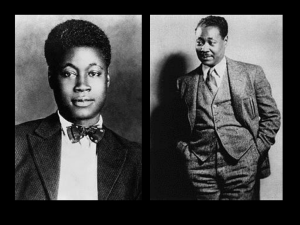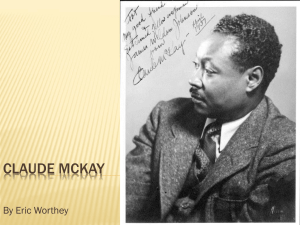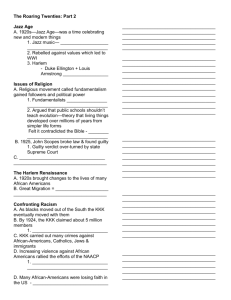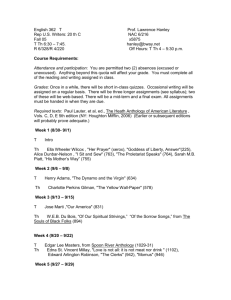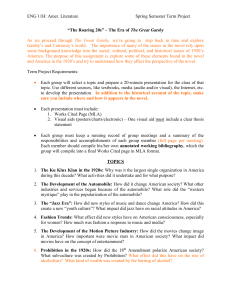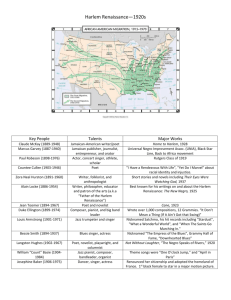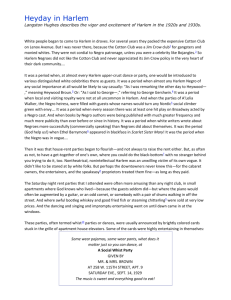The Contagious Fever of the Jungle: Primitivism in Claude
advertisement
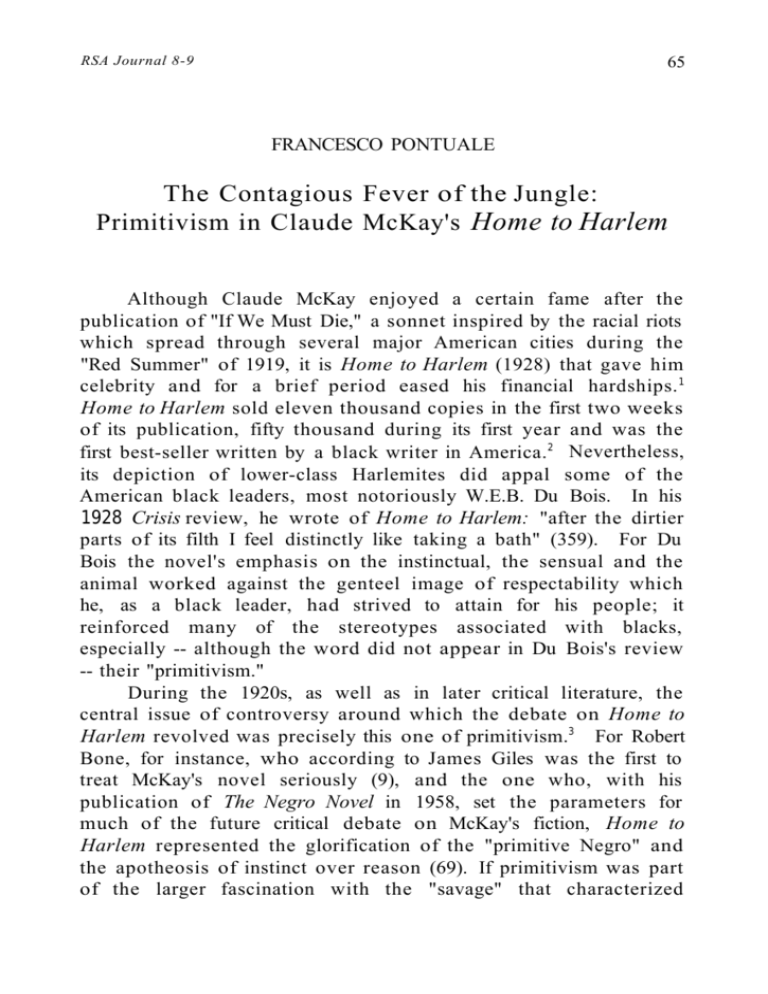
RSA Journal 8-9 65 FRANCESCO PONTUALE The Contagious Fever of the Jungle: Primitivism in Claude McKay's Home to Harlem Although Claude McKay enjoyed a certain fame after the publication of "If We Must Die," a sonnet inspired by the racial riots which spread through several major American cities during the "Red Summer" of 1919, it is Home to Harlem (1928) that gave him celebrity and for a brief period eased his financial hardships. 1 Home to Harlem sold eleven thousand copies in the first two weeks of its publication, fifty thousand during its first year and was the first best-seller written by a black writer in America. 2 Nevertheless, its depiction of lower-class Harlemites did appal some of the American black leaders, most notoriously W.E.B. Du Bois. In his 1928 Crisis review, he wrote of Home to Harlem: "after the dirtier parts of its filth I feel distinctly like taking a bath" (359). For Du Bois the novel's emphasis on the instinctual, the sensual and the animal worked against the genteel image of respectability which he, as a black leader, had strived to attain for his people; it reinforced many of the stereotypes associated with blacks, especially -- although the word did not appear in Du Bois's review -- their "primitivism." During the 1920s, as well as in later critical literature, the central issue of controversy around which the debate on Home to Harlem revolved was precisely this one of primitivism.3 For Robert Bone, for instance, who according to James Giles was the first to treat McKay's novel seriously (9), and the one who, with his publication of The Negro Novel in 1958, set the parameters for much of the future critical debate on McKay's fiction, Home to Harlem represented the glorification of the "primitive Negro" and the apotheosis of instinct over reason (69). If primitivism was part of the larger fascination with the "savage" that characterized 66 RSA Journal 8-9 Modernism and the work of white artists such as Pablo Picasso, Joseph Conrad and D.H. Lawrence, just to mention a few, in McKay's novel primitivism is necessarily intertwined with his racial identity and needs to be addressed within this context. What happens when the writer who is engaged with the idea of primitivism is black and by descent connected to Africa and to "primitive" culture? Further, what if these images and ideas of the primitive are adopted by a writer on the political left?4 In Home to Harlem primitivism is politicized by McKay's race awareness and leftist radicalism. It consequently becomes a way of revaluing and recuperating that which is positive and particular to African American consciousness; it is a critique of the culture and morality of the white American middle class and therefore a political expression of black identity. However, in the exclusion of women from its discourse, and despite McKay's radical leanings, primitivism also betrays the novel's entrenchment in the white patriarchal ideology of individualism fundamental to the American myth. The association of Harlem and the blacks who inhabit it with the primitive was not new when McKay published his novel. Primitivism was a recurrent motif in many American writers of the twenties, both white and black. Carl Van Vechten's Nigger Heaven, for instance, published two years before McKay's novel, in 1926, exploited the ideas of the primitive and the favourable popularity being enjoyed by black culture at the time.5 This was the height of the Harlem Renaissance, "when Harlem was in vogue," in the words of Langston Hughes.6 Although McKay wrote his novel while in Europe, after having spent several years away from the United States, he, too, addressed issues central to this Renaissance and his voice was influential in the "New Negro" movement. Nathan Huggins has located three major factors that contributed to a heightened awareness of, and interest in, the primitive among Americans during the early twentieth century: a popularized Freudianism that regarded civilization as the main reason for neurosis; a rediscovery of African art thanks particularly to post-impressionist painters and sculptors; a widespread disillusion for Western civilization that the Great War had shown at RSA Journal 8-9 67 its worst (Huggins 87-88). Another factor contributing to the growth of primitivism during the Twenties was the liberation of postwar-American society from Puritan sexual ethics. The Twenties are remembered as the "Jazz Age" and their spirit brought a radical change to New York, for whites as well as for blacks, who were streaming into this and other major northern cities from the South. For the thousands of blacks who left the impoverished, racist South, Harlem represented a less prejudiced, more auspicious environment; an opportunity to work, to crawl out from under the influence of the church and an opportunity to escape small­ minded, provincial America. For whites, Harlem and the new urban blacks of New York were exoticized as primitive. More than ever, African Americans became an integral part of what Marianna Torgovnick calls "primitivist discourse." Within this discourse, the primitive is largely identified with subaltern communities -- East-European Jews, Irish, African Americans, women, the working class -- who are relegated to the condition of "Others." These Others are collapsed into one, monolithic mass and, through a variety of tropes, they are associated with intuition, spontaneity, irrationality and uncontrolled sexuality. Western culture creates different versions of the primitive according to its own needs and in order to overcome its own obsessions (Torgovnick 18). After the First World War, when the discontent with Western values was at its highest level, the new urban blacks, in America, came to represent for the white middle class an alternative to the degeneracy of Western civilization. These social and cultural changes coincided with the rise of a new African American radicalism. Although there have been moments and currents of radicalism scattered throughout African American history, according to historian Wilson Moses, its widespread expression in the 1920s was a new phenomenon. Moses claims that "the 1920's ... mark the growth of a spirit of radicalism in black America such as had not been seen since the Civil War" (247). The "accommodationist" policy of Booker T. Washington and Du Bois that conforms to white society, according to Moses, was superseded by a postwar African American consciousness, less concerned with the assimilation of white values 68 RSA Journal 8-9 than with the articulation of a specifically black culture and black values. World War I witnessed the decline of the "civilizationistic" pattern among African Americans. In other words, for blacks, the Great War was the event that marked the end of the belief in a European civilization that was more advanced than other civilizations; the end of the belief in a backward black people who, in order to improve their status, had to conform and adjust to white society. On the contrary, "if [the postwar African American] did not find the world hospitable as it was, he would seek to change the world to suit himself rather than keeping his peace and adjusting to conditions as he found them" (Moses 247). McKay's work participated in this new black ethos. After arriving in New York, his political views became decidedly radical and he was very critical of the politics of Du Bois and the National Association for the Advancement of Colored People (NAACP) whose leaders he compared to "liberal capitalists ... ignorant of the fact that the Negro question is primarily an economic one" ("Socialism and the Negro" 51). Traces of McKay's polemical distance from the NAACP and his political radicalism emerge in Home to Harlem. Its protagonist, Jake, deserts the army in France because he comes to realize that World War I is "a white folks'war" and that "it ain't ever was any of black folks' affair" (8). This opinion was also held by radical African Americans at the time of World War I, people like A. Philip Randolph and Chandler Owen, who befriended McKay and who set themselves against the Tuskegee Machine, Du Bois and their belief that African Americans had to fight beside the Allies against the Germans. Quite unlike McKay and other black radicals, the older generation of black leaders felt that by proving their loyalty to America, by demonstrating that blacks were "real" American nationals, they would improve their second-class social status. In Home to Harlem, not only is the war a "white folks' affair" but the second-class status of African Americans in the army mirrors their second-class status in American society at large. The reader is made aware of this right from the outset of the novel when Jake recalls his job assignment in the army, a job which consists of hauling lumber to build barracks: RSA Journal 8-9 69 I didn't run away because I was scared a them Germans. But I beat it away from Brest because they wouldn't give us a chance at them, but kept us in that rainy, sloppy, Gawd-forsaken burg working like wops [sic]. They didn't seem to want us niggers foh no soldiers. We was jest a bunch a despised hod-carriers. (331)7 Jake experiences how blacks are excluded from the "meaningful" activities of war, i.e. fighting, and given only the menial tasks. It is for this reason that he decides to desert. The novel's leftist politics re-emerge in the fifth chapter, "On the Job Again." Once that Jake is back home in New York, without his being aware, he is employed as a scab worker to replace longshoremen who are on strike. The issues of "scabbing" and of black workers employed as "strikebreakers" that appear in Home to Harlem were recurrent concerns among unionists and African American leaders like Du Bois during the 1920s. Because blacks were excluded from trade unions and relegated to the underclass of chronically unemployed workers, they were often forced to work as scab labor. McKay elaborated on strikebreaking and the anti-unionist policy of the black leaders in the US in his The Negroes in America, a brief Marxist history of the African Americans published originally in Russian in 1923 when McKay was living in the Soviet Union. In his effort to exhort "the best Negro leaders" to destroy the "pernicious anti-union policies so deeply rooted among their people" McKay wrote that there is a large and influential black leadership including ministers, politicians, editors, doctors, lawyers, social workers, etc., who as a matter of race tactics are violently opposed to their people going into the trade unions. They look at strikebreaking as a legitimate and effective means of Negro advancement. (27-28) Jake's reaction to scabbing in Home to Harlem seems to indicate that McKay has become less militant with respect to his position on trade unions. When Jake is asked by a white worker to join the union, he answers: "I ain't a joiner kind of a fellah ... No, pardner, keep you' card" (45-6). However, when a friend of his, Zeddy, condones and praises scabbing -- "I loves life and I got 70 RSA Journal 8-9 to live and I'll scab through hell to live" -- Jake firmly opposes Zeddy's position and quits his job at the New York pier stating that he "won't scab on nobody, not even the orneriest crackers" (48-9). The strikebreaking episodes in H o m e to Ha rlem reveal McKay's sensitivity to the problems of the black working class and are partly a result of his own experience. Before he was able to live from the money he made writing, McKay held a series of menial jobs: stevedore, porter, houseman, dining-car waiter. He identified with the growing black working class and it is in the spirit of this identification that in a letter to James Weldon Johnson, dated April 30, 1928, McKay wrote: "I consider Home to Harlem a real proletarian novel" (Cooper, Claude McKay 247). Although a "proletarian" novel, McKay's Home to Harlem does not have the same kind of militant sentiment that later proletarian novels of the thirties come to have.8 Nevertheless, in it McKay celebrates the black proletarians of Harlem, their lives and vitality: stevedores, cooks, waiters, maids, longshoremen, pims and prostitutes become the repository of a new vitality that white society completely lacks. It is within this larger biographical, artistic and historical context that McKay's use of primitivism in Home to Harlem needs to be considered. The idea, or cult, of primitivism in the novel is the claim for a different black sensibility, a counterculture in opposition to white, middle-class culture, one which recuperates the uniqueness of a black, urban working class and which values its difference from white, European and American, civilization: The deep-dyed color, the thickness, the closeness of [Harlem]. The noises of Harlem. The sugared laughter. The honey-talk on its streets. And all night long, ragtime and "blues" playing somewhere . . . singing somewhere, dancing somewhere! Oh, the contagious fever of Harlem. Burning everywhere in dark-eyed Harlem. (15) Harlem is the locale of primitivism. It is described as a colourful place, teeming with people, vivacity, life and exuberance. It is an exotic and savage place: "when you were fed up with the veneer of Seventh Avenue ... you would go to the Congo and turn rioting loose in all the tenacious odors of service and the RSA Journal 8-9 71 warm indigenous smells of Harlem" (30). Harlem's restaurants and bars are given African names: the "Congo," the "Sheba Palace," the "Nile Queen Restaurant"; its people are compared to raving animals -- "[Jake's] eyes were alert as he sniffed the street like a hound" (10); "Zeddy's gorilla feet dancled] down the dark death lurking in his heart" (54); "like a lean lazy leopard the mulattress reclined against Jake" (38-39); its atmosphere is that of a jungle and its sexuality untamed -- "like shameless wild animals hungry for raw meat, the females savagely search[ing] the eyes of the males" (68). Harlem is a savage place, a place where the instinctual, the animal, the sensual and the sexual thrive.9 Jake is the novel's main representative of primitivism: he follows his instinct; he is impulsive and earthy; he has strong oral and sexual appetites; he likes to revel and to drink excessively. Jake belongs to that mass of blacks who do not have a permanent job, who live day to day, but who, nonetheless, have joie de vivre. By nature he is good, liked by everybody; he is generous, willing to share what he has. In the novel, Jake embodies the virtues of lower-class blacks; his life is a celebration of alternative ways of living, an antidote to the dull conservatism of white society. His primitivism, as Adam Lively has noted, constitutes a "kind of cultural [black] nationalism" (229) that expresses itself in the glorification of "blackness," skin colors and black music. Home to Harlem explores a whole range of blackness, foregrounding the differences within "black" people -- a challenging act in itself in view of how it refutes the monolithic image that whites have of blacks as all the same. The novel is a call for color pride: black, chocolate-to-the-bone, teasing-brown, yellow, nut-brown, lemon, maroon, olive, mauve, gold, are some of the adjectives used to describe "colored" people and give the reader a strong sense of the diversity within black culture. Jake and his alter ego, Ray, are black, but Felice, the woman with whom Jake falls in love, is "a little brown girl" (11) and Agatha, Ray's girlfriend, is "rich-brown" (208). Those shades closest to white are never the preferred colors, as in the case when Jake says: "I ain't much for the high-yallers after having been so much fed-up on the ofays" (36). 72 RSA Journal 8-9 Jazz and blues course throughout McKay's novel and Harlem is identified with this music. Although this identification might now seem obvious, it was not so in the 1920s when jazz and blues represented an embarrassment for certain conservative and assimilationist black elites who wanted access to mainstream America. 10 At this time, jazz was still a cultural form with a strong anti middle-class sentiment. It is in this spirit of rebellion against the middle class that Home to Harlem uses jazz and tries to recreate its rhythms on the page: Turn-tum ... tum-tum ... tum-tum ... turn-tum ... The notes were naked acute alert. Like black youth burning naked in the bush. Love in the deep heart of the jungle ... The sharp spring of a leopard from a leafy limb, the snarl of a jackal, green lizards in amorous play, the flight of a plumed bird, and the sudden laughter of mischievous monkeys in their green homes. Tum-tum ... tum-tum ... tum-tum ... tum-tum ... Simple-clear and quivering. Like a primitive dance of war or of love ... the marshaling of spears or the sacred frenzy of a phallic celebration. (196-97)11 In this description of a pianist playing jazz in a Philadelphia brothel, the rhythms of jazz evoke an exotic, colorful and sensual atmosphere within a primitive scenario. As Lawrence Levine writes, jazz during the Twenties "became associated with what [Aaron] Easman . . . called the 'vital libidinal impulses . . . precisely the id drives that the superego of the bourgeois culture sought to repress'" (293). Blues has an effect similar to that of jazz and the same exotic associations: "Blues," "blues," "blues." Red moods, black moods, golden moods. Curious, syncopated slipping over into one mood. Humming in harmony, barbaric harmony, joy-drunk, chasing out the shadow of the moment before. (54) Here the "barbaric harmony" and rhythmic repetition of the music banish Zeddy's blues, suggesting the way in which black music is used and imagined as a liberating and cathartic force. In his review of the novel, Du Bois wrote that McKay's depiction of Harlemites as hard-core cabaret-goers, jazzing and bluesing all time, was "nonsense" (202). "The overwhelming RSA Journal 8-9 73 majorit y of black folk . . . ne ve r go to ca bare ts. The average co lored man in Harlem is an every day lab orer," w rote Du Bois in ano the r of his articles ." Blacks in Hom e to Harlem might not represent any real black population living in New York City d uring the twenties, but McKay elicits the spirit of black culture a nd its co ntemporary awakening . Du Bois's argume nt is impli citly criticize d in the novel by bla cks like Gin-hea d Susy and Miss Curdy who , in trying to imitate the glamo ur and manners of the petit bourgeoisie, are mocked and chastised. Both Gin-hea d Susy and Miss Curdy are working class: Susy is a coo k; Miss Curdy , once a "b usiness girl," seems now to be une mpl oyed with a purse that is "old and worn and flat" (6 1). Despite thei r d isad van taged so cia l status, however , these wome n set themselves apa rt from Harle m. Miss Curdy boasts o f having been part o f "real society" (87) during her yo uth, w he n she used to associate with the "upstage race gang " (67). Susy , altho ug h she maint ain s that whites "ain 't no different from us," is eventua lly disgu sted by Harlem and pr efe rs the "goodness" an d "q uietness" of Broo klyn . When the two women surprise Zeddy , wh o is going o ut wit h Susy , and find him flirting w ith an other woman in a cabaret, the ir reaction is aga ins t Harle m as a den o f in iqui ty: "I neve r d id hav e any time fo r Harle m." said Miss Curd y. "When I was high up in so ciety a ll respectable co lo red peo ple lived in Wash ingto n. There was no Harle m full a niggers the n." (98) Susy affirm s: "This here Harlem is a stin king sink o f iniq uity. Nigger Hell! Th at's w ha t it is . Look a that theah ugly black nigger loving up a scrimpy brown gal right befoh mah eyes . . . Yessam . th is hcah Harlem is sure nigger hell. Tak e me way awa y from it." (99) 13 The altitude ex pressed by Miss Curdy and Susy is not unli ke that of Du Bo is, "the bla ck Pur itan " (Lively 229) , to wh ose mind McKay's novel was "utterly licentio us." Miss Cu rdy and Gin-head Susy repres e nt those blacks who still want ed to "accommodate" and imitate whit e New York. 74 RSA Journal 8-9 In Home to Harlem, Jake's primitivism is juxtaposed against Ray's cerebral sophistication. The Jake-Ray juxtaposition expresses the contrast between the primitive vitality of the black urban lower­ class and the dangerous effects that white Western civilization can have on it. Ray is the intellectual who has lost his spontaneity because he has been influenced, or "touched", as the novel describes him, by Western civilization. As he says "The more I learn the less I understand and love life" (274). At times he envies Jake's easy-going approach to life and feels his own education is a straitjacket of which he would like to divest himself. As a good Modernist, Ray is an enthusiastic reader of James Joyce and an admirer of the vitalism of D.H. Lawrence and Sherwood Anderson (227); he thinks of life as "one big disease and the world [as] a vast hospital" (229). At the same time, Ray also represents the new black consciousness that was developing during the 1920s. He vindicates a new black culture and its difference from white European and American culture. It is this "newness" that Ray has in mind when he describes white culture as a house: No, modern education is planned to make you a sharp, snouty, rooting hog. A Negro getting it is an anachronism. We ought to get something new, we Negroes. But we get our education like -- like our houses. When the whites move out, we move in and take possession of the old dead stuff. Dead stuff that this age has no use for. (243) For Ray, it is no longer desirable for African Americans to live in a white house; blacks need their own different identity. But because of his extensive education, Ray has difficulty entering into primitivism and the ethics of a new black consciousness. Ray is a black intellectual split between black and white worlds who belongs to neither one. 14 Alienation is his permanent condition and for this reason, at the end of the novel, Ray leaves for Europe while dreaming of losing himself "in some savage culture in the jungles of Africa" (274). It has been said that in the literature by African Americans the search for home is a major motif and the title of McKay's novel is evidence of its recurrence (Rosenblatt 90). For a people who have RSA Journal 8-9 75 been uprooted and moved from one continent to another, the search for home takes on mythic proportions. In Home to Harlem the idea of "going home," and eventually not finding it, overlaps and interacts with the novel's cult of primitivism. Torgovnick has noticed how often the condition of exile and cultural estrangement recurs in the lives of anthropologists and writers who have been interested in the primitive: Bronislaw Malinowski, Franz Boas, Joseph Conrad, D.H. Lawrence, André Gide all led nomadic lives, in search of some ideal place or community. McKay's name could be easily added to this list. "Going primitive" for these men meant "going home," finding a place where they could feel at ease, at one with themselves and their world. Of course such place did not really exist. The search for home becomes what Torgovnick, after Georg Lukács ( The Theory of the Novel), calls "transcendental homelessness," the yearning for an irretrievable "integrated totality," when "men's souls and desires were equivalent." 15 Much twentieth­ century interest in the primitive generated out of this "transcendental homelessness" (Torgovnick 187-88). In Home to Harlem, Ray yearns for an ideal place and often finds himself dreaming of "back home": Home thoughts, if you can make them soft and sweet and misty-beautiful enough, can sometimes snare sleep. There was the quiet, chalky-dusty street and, jutting out over it, the front of the house that he had lived in. The high staircase built on the outside, and pots of begonias and ferns on the landing. ... All the flowering things he loved, red and white and pink hibiscus, mimosas, rhododendrons, a thousand glowing creepers, climbing and spilling their vivid petals everywhere, and bright-buzzing humming­ birds and butterflies. (152-53) This kind of paradise, of course, exists only in Ray's mind; he will not find it in his native Haiti, nor in Harlem, because home is an idea of totality and oneness and not a physical place: his longing for a "home" turns into an endless wandering. 1 6 It could be contended that Home to Harlem's primitivism is gratuitous exoticism designed primarily to titillate a white readership. Some critics, in fact, have argued that the entire Harlem Renaissance was a "failure" because it was economically 76 RSA Journal 8-9 supported by white money and that it became the repository of a white desire for the primitive and the "natural."17 McKay was aware of this risk. In his autobiography A Long Way from Home, he writes: The Negroes were under the delusion that when a lady from Park Avenue or from Fifth Avenue, or a titled European, became interested in Negro art and invited Negro artists to her home, that was a token of Negroes breaking into upper-class white society. I don't think that it ever occurred to them that perhaps such white individuals were searching for a social and artistic significance in Negro art which they could not find in their own society. (321) McKay here seems to locate one of the dangers of being "Other" in Western culture: that of becoming a pawn in the hands of the hegemonic group. Torgovnick writes that "the real secret of the primitive in this century has often been the same secret as ever: the primitive can be -- has been, will be (?) -- whatever Euro­ Americans want it to be. It tells us what we want it to tell us." In itself the primitive is "voiceless, it lets us speak for it. It is our ventriloquist's dummy" (Torgovnick 9). In other words, the primitive comes to articulate the needs of whites rather than those people who are supposedly "primitive." Although generally correct, Torgovnick's argument does not account for any "escape" from a primitive discourse, any way in which the subaltern can re­ appropriate the primitive discourse for itself. McKay was not an American with European roots; he was a Jamaican of African descent who despite the fact that he lived for many years in the USA never became an American citizen. It is true that his use of primitivism runs the risk of falling into stereotypes. By representing black culture as primitive, black people might be understood as "naturally," even essentially, wild, instinctual, and animal. But McKay's own race, his political engagement and race awareness inform his use of primitivism with a different set of values than those of a "lady from Park Avenue or from Fifth Avenue." I recognize that to ascribe to McKay's primitivism a different meaning than that of other white writers simply because of his RSA Journal 8-9 77 racial difference runs the risk of essentialism, but, as Diana Fuss has argued, essentialism per se is neither good nor bad, neither progressive nor reactionary; what should concern us is "to investigate what purpose or function essentialism might play in a particular set of discourses" (xii-xiii). And as I have tried to maintain, drawing on the historical and political context of black America during the Twenties, McKay's primitivism is a political claim for a different black sensibility. If in Home to Harlem primitivism holds a positive political value, it is, however, a value exclusive to men; women are excluded from McKay's political appropriation of primitivist discourse and their representation foregrounds McKay's entrenchment in the patriarchal ideology of American individualism. His attitudes toward women perpetuate on the level of sex the very prejudice that he seeks to eradicate on the level of race. Nathan Huggins suggests that, in Home to Harlem, primitivism is "a male fantasy," as it would probably have been socially unacceptable for women to base their existence on instinct and body (188). In McKay's novel, women do not partake in the new primitive sensibility of which the lower-class Harlemites are part; on the contrary, these female characters belong to a long tradition of sexist and even misogynist writing that represents them as depraved, coarse and jealous. Women like cabaret singer Congo Rose want to be dominated and abused by men: "Rose was disappointed in Jake. She had wanted him to live in the usual sweet way, to be brutal and beat her up a little, and take away her money from her" (113). 18 Women are pitted against each other, as with Gin-head Susy who, "like so many of her sex, she had a congenital contempt for women" (58). Women fight with each other over men, like the two West Indians: "the laundress was crazy with suspicion and jealousy and a feeling for revenge. She challenged her rival to fight the affair out" (308). In Home to Harlem sex among black women, more often than not, is something to be bought and sold. Almost all of the female characters are prostitutes or part-time prostitutes and this situation is entirely domesticated, normalized, without any critique of the fact that prostitution is almost the only occupation open to black women in which they can make a decent wage. In a move that 78 R SA Journal 8-9 out of this misogynous context could be interpreted as progressive, McKay romanticizes Rosalind's relationship to her pimp, Jerco, who sells his clothes in order to pay for her medicine and doctor's bill and finally commits suicide when she succumbs to her illness. Even Ray, a supposed intellectual, perpetuates this sentimentalization but his interest is not in the whore but her pimp with whom he identifies and finds sympathetic: "all men have the disease of pimps in their hearts" (243-44). Not only are women excluded from the politics of primitivism but they are also excluded from any serious relation with men: Negroes, like all good Americans, love a bar . . . We like to lean up against it, with a foot on the rail. We will leave our women companions and choice wines at the table to snatch a moment of exclusive sex solidarity over a thimble of gin at the bar. (324) When the aim is to undermine women, even racial differences are disregarded and "Negroes" become like all white Americans. The lack of respect for women that Home to Harlem betrays, their exclusion from the new black consciousness expressed through primitivism is generated out of the homosocial (homoerotic?) 19 atmosphere that prevails throughout the text. This male bonding or "sex-solidarity" is part of a myth of American individualism which Home to Harlem extols. At the end of the novel, Jake leaves New York and tries to "make a go of it" in Chicago together with Felice, the woman he loves. Despite his final commitment to Felice, though, Jake betrays a profound sense of individualism throughout the novel. Like many others heroes of American literature, Jake fears that some external force will interfere with his own choices, his liberty; that someone else will take control of his life. He therefore chooses to remain in his own "system," although eventually a system of two. 2 0 To the worker who asks him to be a member of the union, Jake answers, "No, pardner, keep you' card. I take the best I k'n get as I goes mah way' (emphasis added 45-46). "Mah way" could be Jake's theme song in the novel. He rejects any limits that are placed upon his "freedom," like those of resulting from his RSA Journal 8-9 79 relationship with Rose and this is part of the reason that he leaves her. Jake is described as "one of those unique types of humanity who lived alone and were never lonely .. . the Alpha and Omega himself" (234). Although Jake is the quintessential Harlemite, although his primitivism makes him the representative of the new black sensibility, in the final analysis he constitutes a world of his own, apart from the black community, an individual squarely within the white "American" tradition. 21 Home to Harlem uses primitivism to establish and celebrate a new radical, black consciousness, on the political left, that opposes dominant white middle-class American culture. At the same time, however, it is trapped by the ideology of individualism and attitudes toward women that perpetuate on the level of sex the very prejudice that McKay sought to eradicate on the level of race. If it is true, as Wayne Cooper argues in his foreword to the 1987 edition of the novel that, "of all the major Afro-American writers who emerged in the 1920s, Claude McKay remains the most controversial and least understood," certainly Home to Harlem is still a very controversial novel. 1 Born in Jamaica in 1890, Claude McKay made exile the salient feature of his existence. After he left his native Island In 1912, he lived in the United States, England, Russia, Germany, France, Spain, and Morocco. When he first reached New York City, in 1914, he published poetry and prose for Max Eastman's Liberator, the radical Journal affiliated with the American Communist Party. In 1922, McKay left the United States to participate in the Fourth Congress of the Third Communist International in Moscow. His Russian experience was only the beginning of a long exile that kept him away from America for twelve years . It was during his sojourn in Europe and North Africa that he wrote most of his fiction three novels, Home to Harlem (1928), Banjo (1929), Banana Bottom (1933) and his collection of short stones, Gingertown (1932) . Because of the commercial failure of his last two books, McKay was forced to return to New York City. In 1934 where he managed to complete his autobiography A Long Way from Harlem (1937) and to publish Harlem. Negro Metropolis (1940), a sociological study of the black ghetto. When he died in Chicago, in 1948, all of his ten books, including four volumes of poetry, were out of print For an elaboration of McKay's biography, see Wayne Cooper's Claude McKay: Rebel Sojourner in the Harlem Renaissance (1987), the most extensive study of the writer's life and work to date, and Tyrone Tillery's Claude McKay: A Black Poet's Struggle for Identity (1992) . 2 In Roots of Negro Racial Consciousness Stephen H. Bronz writes that, "sensing the book's appeal to whites, the publisher, Harper & Brothers, lured a popular old Negro wagon driver to tote a six-foot high enlargement of the hook's cover around New York City in his wagon" (83). 80 RSA Journal 8-9 3 For a more detailed discussion of the contemporary critical reactions to Home to Harlem, see Cooper, Claude McKay 243-48 and Tillery, Claude McKay 87-9 . 4 Although later in his life McKay radically changed his politics and became in Harlem: Negro Metropolis very critical of the Communists, Home to Harlem still belongs to the period of his early involvement with Marxism and socialist ideas. On Mckay's later years and especially on his conversion to Catholicism, see Barbara J. Griffin's article, "Claude McKay: The Evolution of a Conservative," CLA Journal 36 (September 1922): 157-70. 5 Other novels written by white writers during the 1920s that take the "Negro" as literary subject include Eugene O'Neill' s The Emperor Jones (1920) and All God 's Chillum Got Wings (1924), E.E Cummings's The Enormous Room (1922), Waldo Frank's Holiday (1924), Ronald Firbank's Prancing Nigger (1924), Sherwood Anderson's Dark Laughter (1925), DuBose Heyward's Porgy (1925) and Mamba' s Daughters (1927) . 6 This famous phrase appeared for the first time in Langston Hughes's autobiography, The Big Sea (1940), in the section devoted to the Harlem Renaissance . 7 Historically, the treatment of blacks in the army was quite different from the treatment of whites. During WWI, the Navy, for instance, allowed blacks to serve only as "mess boys", the Marines did not accept blacks in any capacity; the Army accepted blacks in all branches except the pilot section of the Air Corps. The entire military was segregated (Wintz 11). 8 Walter B. Rideout's The Radical Novel in the US (Cambridge, Mass.: Harvard Un iversity Press, 1956) is still today one of the most exhaustive and best documented studies available on the American "proletarian novel". 9 In such a depiction of Harlem one might be well advised to bear in mind McKay's memories of the tropical landscape of his native Jamaica 10 James De Jongh reminds us that Langston Hughes's The Weary Blues, published in 1926, received a negative response partly because of its use of jazz and blues as literary material (Vicious Modernism, 24). 11 Of course, in a passage like this, Modernism and McKay's own expertise in poetry are also decisive influences. 12 I am here referring to Du Bois's review of Van Vechten's Nigger Heaven, published in The Crisis 33 (1926), 81. 13 Wayne Cooper maintains that, although McKay in 1924 knew that white critic and novelist Carl Van Vechten was writing a novel about Harlem, he did not, in fact, see Van Vechten's Nigger Heaven until after the publication of Home to Harlem (The Passion of Claude McKay, 28) From the passage quoted above, however, the allusions to Carl Van Vechten's novel seem quite obvious. 14 Ray's dilemma echoes W E.B Du Bois's concept of "twoness ". In a famous passage from The Souls of Black Folk (1903), Du Bois writes about the condition of being black in America: "One ever feels his twoness - an American, a Negro, two souls, two thoughts, two unreconciled strivings; two warning ideals in one dark body, whose dogged strength alone keeps it from being torn asunder" (215). In Ray the "double-consciousness" becomes a condition of alienation or, as I argue, in the body of my paper, of "transcendental homelessness " 15 The Lukácsian notion of "integrated totality" has come under attack in later Marxist theories, primarily those of Louis Althusser. However, the end of the "unified subject" RSA Journal 8-9 81 formulated by post-structuralism does not necessarily imply a more revolutionary critical and political practice. As Giorgio Mariani suggests, "Can one say that narrativ fragmentation is always conducive to a deconstruction of the dominant ideology? That an incoherent understanding of crucial social or historical facts should always be preferred to any kind of 'totalizing' interpretation. That all consistent interpretative models are necessarily reactionary?... While one does not have to be nostalgic, as Lukács often was, for the lost days of epi c wholeness, it is euqlly idealistic to see subversive intents in any narrative where the events described, to quote Lukács, 'b e a r little obvious re la tions hip ... to any larger totality" (20-21) 16 Ray reappears in McKays Banjo (1929) where we find him not in an African Jungle but a mo n g the "beach boys" of the Marseilles waterfront, still trymg to free himself from the fetters of civilization, still looking for his "brand-new house", still in search of a place where he can eventually be at home . Ray, eventually, runs away with Banjo, the eponymous hero of the novel, to some other unknown place . 17 This is in part Nathan Huggins' s thesis in his Harlem Renaissance and it is also the main argument of Ralph D. Story's article, "Patronage and the Harlem Renaissance: You Get What You Pay For" CLA Journal 32 (March 1989): 284-95. 18 Hazel V. Carby has argued that within the migration of black people to Northern cities in the first half of the twentieth century, urban black women have often been seen, "as signs of various possible threats to the emergence of the wholesome black masculinity necessary for the establishment of an acceptable black male citizenship in the American social order." Therefore, Jake's refusal to beat Congo Rose is in Carby's view, "a triumph of wholesome masculinity over the degenerate female element and allows Jake to proceed on his journey to become a man. " A man, of course, who is defined in terms of the misogynist tradition that I am here underlying ("Policing the Black Woman's Body" 747, 750) . 19 McKays sexual and sentimental life included partners of both sexes, but McKay rarely discusses homosexuality in his writings and never acknowledged it publicly. Wayne Cooper has located only one poem, "Rest In Peace," in which McKay explicitly mentions one of his homosexual affairs and one chapter of his unpublished novel, "Romance in Marseille," which celebrates gay life (Claude McKay, 75). 20 Tony Tanner in City of Words maintains that there is an "abiding American dread" that runs throughout American literature; the dread "that there are all sorts of invisible plots afoot to rob you of your autonomy of thought and action" (15). Tanner points out that in order to resist the conditioning forces of the external world, American fictional characters often isolate themselves in their own worlds, their own "systems" in a very Romantic tradition that goes back at least as far as William Blake who in "Jerusalem writes "I must Create a System or be enslav'd by another Man's" (16) 21 His relationship with Felice, however, does not last very long Like Ray, Jake too returns briefly in Banjo where he is reunited with his old friend. In the chapter entitled "The Chauffeur's Lot," Jake tells Ray that after he and Felice left New York City for Chicago they had a baby boy, got married, returned to Harlem within two years hut that soon he sickened of his ordinary life "I soon finds out . . . that it was no joymaking business for a fellah like you' same old Jake, chappie, to go to work reg'lar every day and come home every night to the same ole pillow" (292) . Jake, then, decides to leave his family and go abroad; it is on this occasion that he meets Ray in Marseilles. RSA Journal 8-9 82 Works Cited Bone, Robert A., The Negro Novel in America, New Haven, Conn., Yale University Press, 1958. Branz, Stephen H., Roots of Negro Racial Consciousness, New York, Libra, 1964. Carby, Hazel V., "Policing the Black Woman's Body in an Urban Context", Critical Inquiry 18 (Summer 1992): 738-55. Cooper, Wayne F., Claude McKay: Rebel Sojourner in the Harlem Renaissance: A Biography, Baton Rouge, Louisiana State University Press, 1987. - - -, The Passion of Claude McKay: Selected Prose and Poetry, 1912-1948, York, Schocken Books, 1973. New De Jongh James., Vicious Modernism. Black Harlem and the Literary Imagination, Cambridge, Mass., Cambridge University Press, 1990. Du Bois, W E.B., "Home to Harlem and Quicksand", Crisis 35 (June 1928). 202. Rpt. in Voices of a Black Nation. Political journalism in the Harlem Renaissance, Ed. Theodore G. Vincent. San Francisco, Rampart Press, 1973, pp. 359-60. - - -, The Souls of Black Folk (1903). In Three Negro Classics. Intr. John Hope Franklin. New York, Avon, 1965. Fuss, Diana, Routledge, 1989. Giles, James R., Essentially Speaking: Feminism Nature and Difference, New York, Claude McKay, Boston, Twayne Publishers. 1976. Huggins, Nathan Irvin, Harlem Renaissance, New York, Oxford University Press, 1971. Levine, Lawrence W., Black Culture and Black Consciousness. Afro-American Folk Thought From Slavery to Freedom, New York, Oxford University Press, 1977. Mariani, Giorgio, Spectacular Narratives. Representation of Class and War in Stephen Crane and the American 1890s, New York, Peter Lang, 1992. Lively, Adam. "Continuity and Radicalism in American Black Thought, 1914-1929", Journal of American Studies 18 (1984) 207-35. McKay, Claude, Banjo. A Story Without a Plot, New York, Harcourt Brace Jovanovich, 1957. RSA Journal 8-9 83 - - -, Home to Harlem , Foreword by Wayne F. Cooper, Boston, N o r t h e a s t e r n University Press, 1987. - - -, A Long Way From Home, New York, Lee Furman, 1937. The Negroes in America, Trans. Robert Winter, Ed. Alan L. McLeod, Port Washington, NY, Kennikat Press, 1979. Originally published as Negry v Amerike, Moscow, 1923. - - -, "Socialism and the Negro", Workers 'Dreadnought, 31 January 1920, Rpt. in The Passion of Claude McKay: Selected Prose and Poetry, 1912-1948. Ed. Wayne Cooper. New York, Schocken Books, 1973. 50-54. Moses, Wilson J., The Golden Age of Black Nationalism, 1850- 1925 . Hamden, Conn., Archon, 1978. Rosenblatt, Rogers, Black Fiction, Cambridge, Mass., Cambridge University Press, 1974 Tanner, Tony, City of Words. American Fiction 1950-1970, New York, Harper and Row, 1971. Tillery, Tyrone, Claude McKay: A Black Poets Struggle for Identity. Amherst, University of Massachusetts Press, 1992. Torgovnick, Marianna, Gone Primitive: Savage Intellect, Modern Lives, Chicago, Chicago University Press, 1990. Wintz, Cary D., Black Culture and the Harlem Renaissance, Houston, Tex., Rice University Press, 1988.


